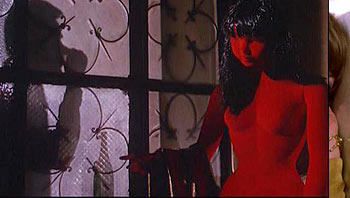http://en.wikipedia.org/wiki/Blood_and_Black_Lace
Vivid
visuals, cold killings, and plenty of pulchritude fill the screen from
beginning to end in the fully restored, unrated and uncut DVD. The
strangulation killings and scenes of torture are pretty shocking, even
by present standards — and this is probably because, unlike some modern
filmmakers who just go for the gore, Bava doted on themes of dread,
fear, and suspense leading up to the bloody bits. That's what makes this
somewhat dated fright flick still scary, nearly 45 years after its
first theatrical release.
The imagery in Blood and Black Lace,
exploited to the limit in vibrant Technicolor, is truly sumptuous: the
main location for the murderer's misdeeds, Christiana Haute Couture, is
architectured just like a classic haunted house. Furthermore the set
decoration, with its blood-red velvet-flocked manikins, shadowy dress
forms, dark dressing rooms and creepy closets sets the perfect stage for
murders most foul. The characters, each one stretched to the limit just
shy of caricature, are compulsively watchable, and the mystery includes
just enough of them to keep you guessing throughout.
Staci Layne Wilson
The roots of the Hollywood slasher are often traced back to Blood and Black Lace, yet Mario Bava's seminal giallo has a richness of texture and complexity of gaze that have kept its elaborate carnage scintillating even following decades of leeching from genre vultures. A blood-drenched mod-whodunit, it kicks off with a young woman ambling through the misty woods, only to be strangled by a trenchcoated, fedoraed figure—her body is dragged out of the frame just as the camera pans left to reveal statues of cherubs in the garden. Christiana is the name of the haute couture fashion house where the other characters are assembled, though spiritual salvation may be the last thing in their minds; presided over by salon owner Cameron Mitchell and recently widowed countess Eva Bartok, the place is, under its coolly elegant surface, a seething vipers' nest of greed, drugs, abortions, blackmail, and, especially, sadistic slaughter, for the killer is barely getting started. Decadent visualist as well as severe moralist, Bava locates the macabre beauty at the heart of his art in this fashion-world dollhouse, where the models, both human and inanimate, become the main canvases for the sensual lushness of the mise en scène; the witty opening credits already suggest the link by posing the cast in sinister tableau, and mannequins are trenchantly arranged throughout as mute witnesses to the spectacle of human malice.
Fernando F. Croce
http://www.slantmagazine.com/film/review/blood-and-black-lace/1849
One of the most chillingly sadistic gialli of all times, this 1964 masterpiece has lost none of its power. Director Mario Bava, the king of Italian horror, cleared the path for Dario Argento and others with this film, though it was not his first effort in the field. In 1962, Bava delivered what was probably the first Italian thriller, La ragazza che sapeva troppo. But whereas La ragazza was a relatively straight-forward murder mystery, this film ignores plot and character in favor of concentrating on the link between cinema and spectacle. The story deals with a series of gruesome murders which are plaguing the chic Haute Couture fashion salon: one by one, the lovely models are horribly murdered by a mad man who appears to be operating with no real motive. The police write the killer off as a sex maniac, but the truth of the matter is that the salon is a veritable hot bed of sex, drugs, and sordid dealings. A diary, loaded with information about these indiscretions, is making the rounds between the various models, and the killer is obsessed with tracking it down before his/her indiscretions are revealed. Though structured as a murder mystery--the German co-producers no doubt wanted Bava to deliver an Edgar Wallace-style thriller--the director takes the film off into unexpected, visionary directions. Even more so than Argento or Fulci, Bava seems fascinated by images of violent death. Yet whereas former med student Fulci insisted on dousing his corpses with blood and gore, former painter Bava keeps the bloodshed to a minimum, instead concentrating on the violent death throes which are shot in a eerily beautiful manner. The very first slasher film, though that label belittles Bava's achievement somewhat. Unlike later hack-em-up directors, Bava is very conscious of the links between the viewer and the cinematic process. By encouraging the viewer to identify with the killer's pleasure-i.e., we think the killings are beautiful in the same way that he no doubt does-Bava makes a very powerful statement on the power of the image. The characters are flat and one-dimensional, because they need to be. There are no heros, only victems. The police are depicted as arrogant and ineffectual, in contrast to most films of this era, Bava does not encourage the viewer to identify with anyone beyond the killer. Within the microcosmic environment of the fashion salon, Bava makes some telling comments on society, as well. Visionary filmmaking at its best.
Troy Howarth
http://uk.imdb.com/title/tt0058567/reviews?ref_=tt_urv





No comments:
Post a Comment